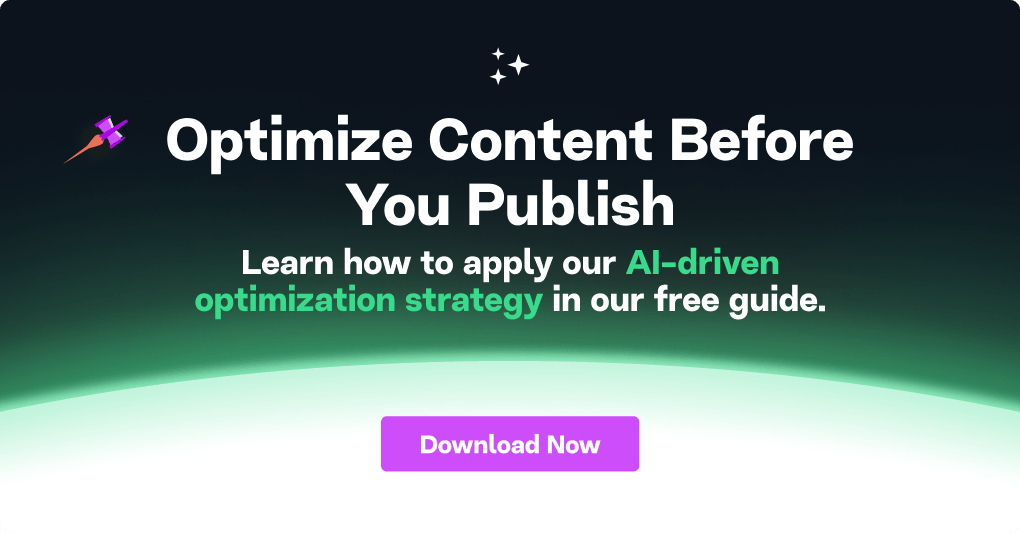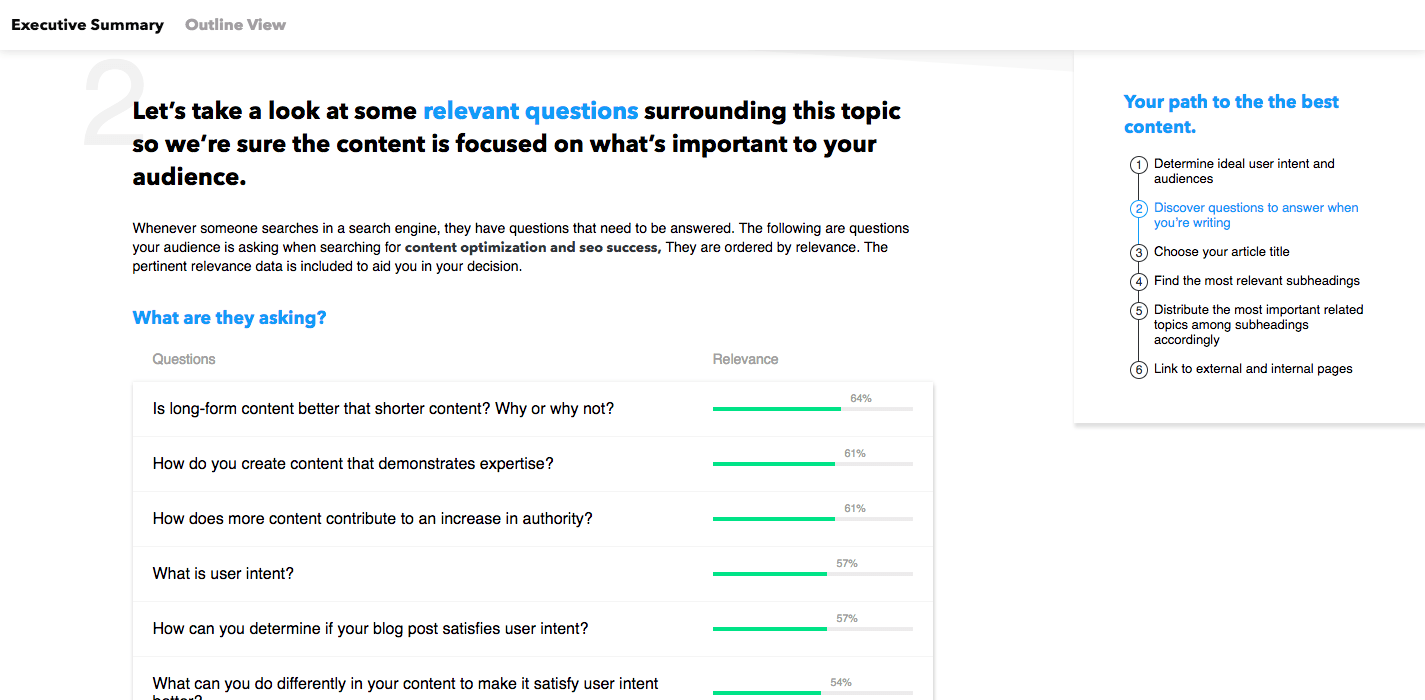Content Optimization and SEO Success
Content optimization is good for both SEO and content marketing, whether you’re creating a new piece or improving something old. For years Google has been working to eliminate spam from search results and continually encourages the creation of quality content.
So it’s not all that surprising to see that content plays a major role in five of the 10 most critical SEO success factors. Cyrus Shepard, who conducted the study, reports that “Sites at the top of Google search results typically score well in most, if not all, of these critical SEO success factors.”
In the study, Cyrus classifies 100 Google ranking factors according to their level of impact. Let’s take a look at the five most critical factors in which content plays a vital role.

SEO-Friendly Content That Targets User Search Queries
Behind every search query is a question. In the age of semantic SEO, creating content that does well in search rankings requires writing articles that target those questions. Here’s an example from a MarketMuse Content Brief.

With a document like this, it’s easy. But if you’re not using content optimization software like MarketMuse Suite, all is not lost.
You can try a free tool like AnswerThe Public and see what results you get. Unfortunately, when I ran it for the topic “content optimization and SEO success” I got nothing.

If that doesn’t work, you’ll need to manually analyze the first page of the SERPs to determine what questions these high-ranking articles are answering.
Or you can just hope to get it right. But hope isn’t a good SEO strategy.
Blog Posts That Satisfy User Intent
Creating high-quality content isn’t about finding the right keywords to use. In fact, it has little to do with keywords.
The best content is that which gives the searcher the best answer, so they can stop searching. That’s what satisfying user intent is all about. Giving people what they want seems like an obvious marketing strategy. Keep it in mind while optimizing your content and your search rankings will dramatically improve. How can a search engine tell that your page doesn’t satisfy user intent? There are a few ways:
- If a user immediately clicks the browser back button after visiting your site
- If they modify their search
- If they spend more time on other sites relative to yours
Satisfying user intent requires:
- understanding who your audience is
- why they are searching
MarketMuse Content Briefs provide that information for each piece of content. But if you don’t have access to them, it just means you’ll need to spend some time figuring out the answers. Make sure to do this before commencing research.

High-Quality Content That Is Unique
Search engines don’t apply a duplicate content penalty, per se. What they do is filter out all the duplicate content so that searchers are presented with only the best and most relevant original content.
How does this affect content creation and optimization? Focus on creating unique content that offers value; the kind that creates authority for your site.
Be careful when curating content, particularly incorporating it into original material. If your post doesn’t contain enough unique material, it could be flagged as duplicate.
Also, watch out if you’re syndicating or cross-posting to another site. In this case, the other site hosting your content must include a proper canonical link. Just to be safe, include the canonical link in your original article and reference it as the authentic post.
Long-Form Content Exhibiting Expertise, Authority and Trustworthiness
Here at MarketMuse, our SEO strategy is to ensure every blog post published provides the most in-depth coverage on that particular focus topic. But they don’t necessarily have to be long. After all, length is a relative measure.

Though SEO experts may disagree, long content isn’t necessarily better than short content. It’s just longer.
So don’t ramble.
Instead of length, focus on information density. Pack as much information as possible into as few words. Do not use two words where one will do.
The web audience is typically looking for answers to their questions. They’re not reading primarily for enjoyment. So they appreciate you getting to the point quickly.
Consequently, they’re less likely to hit the back button and instead, spend more time reading. That type of on-page SEO signal is priceless.
While one in-depth blog post on a specific topic can help build expertise, multiple pages examining the topic from all possible angles contribute to building authority.
Keep creating content and you’ll become the goto site for that topic! We refer to these groups of content as content clusters.
Make sure to link between the different pages in a cluster to make search engines aware of the relationship. Let’s not forget about outbound links. They’re the resources you link to from within your content.
Make sure you only to trustworthy sites that are not direct competitors in the search results. MarketMuse Suite handles this with great finesse. If you’re doing this manually, make sure you don’t link to any pages that rank for your focus topic.
From an SEO perspective, it’s just not a good idea; because a link is like a vote for the competition. It’s a common error that even seasoned content marketing professionals make.
SEO Copywriting That’s Fresh
Does freshness count? Well, over the years Google has filed various patents for document scoring based on content document update. News and events are obvious search query types that benefit from freshness, but others can too. Although you may not need to update every blog post, stale content can have negative consequences such as:
- fewer people linking to your page (reduced link velocity)
- reduction in engagement metrics (like time spent on page)
Also, age, the amount of content updated, and frequency of update are signals that search engines can interpret. But don’t go crazy and update just for the sake of it. Remember, the goal of each blog post is to provide the most relevant and in-depth coverage.
Meta Descriptions That Increase Click-through Rate
A meta description is often used by search engines to populate the area beneath the page title and URL that appears in search engine results.

Google dynamically generates search snippets. Sometimes they use what’s in the meta description and other times they use part of the tag along with content from the page.
While it does not influence ranking directly, a well-written description can influence the click-through rate, which in turn can impact your ranking. A good meta description accurately describes the contents of the page and convinces the user that it’s the page they’re looking for.
Don’t forget your title tag! That’s the most prominent element in any search engine result. OK, maybe those ads are more prominent, but you know what I mean. Like your meta description, your title tag should accurately describe the content of the page while encouraging click-throughs.
Take Action
Stop fretting over finding the right long-tail keywords to target. Accept that off-page SEO is outside of your control. Focus your internet marketing strategy on creating the best content possible. It’s a great way to win over both search engines and customers.
Featured image vector designed by Freepik
What you should do now
When you’re ready… here are 3 ways we can help you publish better content, faster:
- Book time with MarketMuse Schedule a live demo with one of our strategists to see how MarketMuse can help your team reach their content goals.
- If you’d like to learn how to create better content faster, visit our blog. It’s full of resources to help scale content.
- If you know another marketer who’d enjoy reading this page, share it with them via email, LinkedIn, Twitter, or Facebook.
Stephen leads the content strategy blog for MarketMuse, an AI-powered Content Intelligence and Strategy Platform. You can connect with him on social or his personal blog.